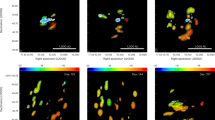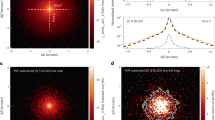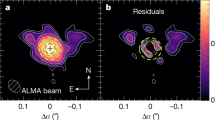Abstract
Stars form by accreting material from their surrounding disks. There is a consensus that matter flowing through the disk is channelled onto the stellar surface by the stellar magnetic field. This is thought to be strong enough to truncate the disk close to the corotation radius, at which the disk rotates at the same rate as the star. Spectro-interferometric studies in young stellar objects show that hydrogen emission (a well known tracer of accretion activity) mostly comes from a region a few milliarcseconds across, usually located within the dust sublimation radius1,2,3. The origin of the hydrogen emission could be the stellar magnetosphere, a rotating wind or a disk. In the case of intermediate-mass Herbig AeBe stars, the fact that Brackett γ (Brγ) emission is spatially resolved rules out the possibility that most of the emission comes from the magnetosphere4,5,6 because the weak magnetic fields (some tenths of a gauss) detected in these sources7,8 result in very compact magnetospheres. In the case of T Tauri sources, their larger magnetospheres should make them easier to resolve. The small angular size of the magnetosphere (a few tenths of a milliarcsecond), however, along with the presence of winds9,10 make the interpretation of the observations challenging. Here we report optical long-baseline interferometric observations that spatially resolve the inner disk of the T Tauri star TW Hydrae. We find that the near-infrared hydrogen emission comes from a region approximately 3.5 stellar radii across. This region is within the continuum dusty disk emitting region (7 stellar radii across) and also within the corotation radius, which is twice as big. This indicates that the hydrogen emission originates in the accretion columns (funnel flows of matter accreting onto the star), as expected in magnetospheric accretion models, rather than in a wind emitted at much larger distance (more than one astronomical unit).
This is a preview of subscription content, access via your institution
Access options
Access Nature and 54 other Nature Portfolio journals
Get Nature+, our best-value online-access subscription
$29.99 / 30 days
cancel any time
Subscribe to this journal
Receive 51 print issues and online access
$199.00 per year
only $3.90 per issue
Buy this article
- Purchase on Springer Link
- Instant access to full article PDF
Prices may be subject to local taxes which are calculated during checkout


Similar content being viewed by others
Data availability
This work is based on observations collected at the European Southern Observatory (ESO) under ESO programme 0102.C-0408(C). The raw data are publicly available in the ESO Science Archive Facility. The reduced data that support the findings of this study are available from the corresponding author under reasonable request.
References
Kraus, S. et al. The origin of hydrogen line emission for five Herbig Ae/Be stars spatially resolved by VLTI/AMBER spectro-interferometry. Astron. Astrophys. 489, 1157–1173 (2008).
Eisner, J. A. et al. Near-infrared interferometric, spectroscopic, and photometric monitoring of T Tauri inner disks. Astrophys. J. 669, 1072–1084 (2007).
Perraut, K. et al. A disk wind in AB Aurigae traced with Hα interferometry. Astron. Astrophys. 596, A17 (2016).
Kurosawa, R. et al. Probing the wind-launching regions of the Herbig Be star HD 58647 with high spectral resolution interferometry. Mon. Not. R. Astron. Soc. 457, 2236–2251 (2016).
Garcia Lopez, R. et al. Probing the accretion-ejection connection with VLTI/AMBER. High spectral resolution observations of the Herbig Ae star HD 163296. Astron. Astrophys. 576, A84 (2015).
Caratti o Garatti, A. et al. AMBER/VLTI high spectral resolution observations of the Brγ emitting region in HD 98922. A compact disc wind launched from the inner disc region. Astron. Astrophys. 582, A44 (2015).
Hubrig, S., Carroll, T. A., Schöller, M. & Ilyin, I. The prevalence of weak magnetic fields in Herbig Ae stars: the case of PDS 2. Mon. Not. R. Astron. Soc. 449, L118–L122 (2015).
Alecian, E. et al. A high-resolution spectropolarimetric survey of Herbig Ae/Be stars—I. Observations and measurements. Mon. Not. R. Astron. Soc. 429, 1001–1026 (2013).
Banzatti, A. et al. Kinematic links and the coevolution of MHD winds, jets, and inner disks from a high-resolution optical [O I] survey. Astrophys. J. 870, 76 (2019).
Simon, M. N. et al. Tracing slow winds from T Tauri stars via low-velocity forbidden line emission. Astrophys. J. 831, 169 (2016).
Huang, J. et al. CO and dust properties in the TW Hya disk from high-resolution ALMA observations. Astrophys. J. 852, 122 (2018).
van Boekel, R. et al. Three radial gaps in the disk of TW Hydrae imaged with SPHERE. Astrophys. J. 837, 132 (2017).
Calvet, N. et al. in Protostars and Planets IV 377−399 (Univ. Arizona Press, 2000).
Manara, C. F. et al. Gas content of transitional disks: a VLT/X-Shooter study of accretion and winds. Astron. Astrophys. 568, A18 (2014).
Venuti, L. et al. X-shooter spectroscopy of young stars with disks. The TW Hydrae association as a probe of the final stages of disk accretion. Astron. Astrophys. 632, A46 (2019).
Donati, J. F. et al. The large-scale magnetic field and poleward mass accretion of the classical T Tauri star TW Hya. Mon. Not. R. Astron. Soc. 417, 472–487 (2011).
Muzerolle, J., Hartmann, L. & Calvet, N. A Brγ probe of disk accretion in T Tauri stars and embedded young stellar objects. Astron. J. 116, 2965–2974 (1998).
Alcalá, J. M. et al. X-shooter spectroscopy of young stellar objects. IV. Accretion in low-mass stars and substellar objects in Lupus. Astron. Astrophys. 561, A2 (2014).
Akeson, R. L. et al. Radial structure in the TW Hya circumstellar disk. Astrophys. J. 728, 96 (2011).
Pascucci, I. et al. The photoevaporative wind from the disk of TW Hya. Astrophys. J. 736, 13 (2011).
Ercolano, B., Rosotti, G. P., Picogna, G. & Testi, L. A photoevaporative gap in the closest planet-forming disc. Mon. Not. R. Astron. Soc. 464, L95–L99 (2017).
Fang, M. et al. A new look at T Tauri star forbidden lines: MHD-driven winds from the inner disk. Astrophys. J. 868, 28 (2018).
Muzerolle, J., Calvet, N. & Hartmann, L. Emission-line diagnostics of T Tauri magnetospheric accretion. II. Improved model tests and insights into accretion physics. Astrophys. J. 550, 944–961 (2001).
Kurosawa, R., Romanova, M. M. & Harries, T. J. Multidimensional models of hydrogen and helium emission line profiles for classical T Tauri stars: method, tests and examples. Mon. Not. R. Astron. Soc. 416, 2623–2639 (2011).
Gullbring, E., Hartmann, L., Briceno, C. & Calvet, N. Disk accretion rates for T Tauri stars. Astrophys. J. 492, 323 (1998).
Gregory, S. G., Matt, S. P., Donati, J. F. & Jardine, M. The non-dipolar magnetic fields of accreting T Tauri stars. Mon. Not. R. Astron. Soc. 389, 1839–1850 (2008).
Romanova, M. M., Long, M., Lamb, F. K., Kulkarni, A. K. & Donati, J. F. Global 3D simulations of disc accretion on to the classical T Tauri star V2129 Oph. Mon. Not. R. Astron. Soc. 411, 915–928 (2011).
Bessolaz, N., Zanni, C., Ferreira, J., Keppens, R. & Bouvier, J. Accretion funnels onto weakly magnetized young stars. Astron. Astrophys. 478, 155–162 (2008).
Johnstone, C. P. et al. Classical T Tauri stars: magnetic fields, coronae and star-disc interactions. Mon. Not. R. Astron. Soc. 437, 3202–3220 (2014).
Gravity Collaboration. First light for GRAVITY: phase referencing optical interferometry for the Very Large Telescope Interferometer. Astron. Astrophys. 602, A94 (2017).
Lapeyrere, V. et al. GRAVITY data reduction software. In Proc. SPIE Optical and Infrared Interferometry IV Vol. 9146, 91462D (SPIE, 2014).
Eisner, J. A., Chiang, E. I. & Hillenbrand, L. A. Spatially resolving the inner disk of TW Hydrae. Astrophys. J. 637, L133–L136 (2006).
Sokal, K. R. et al. Characterizing TW Hydra. Astrophys. J. 853, 120 (2018).
Eisner, J. A. et al. Time-variable accretion in the TW Hya star/disk system. Astrophys. J. 722, L28–L32 (2010).
Vacca, W. D. & Sandell, G. Near-infrared spectroscopy of TW Hya: a revised spectral type and comparison with magnetospheric accretion models. Astrophys. J. 732, 8 (2011).
Weigelt, G. et al. Near-infrared interferometry of η Carinae with spectral resolutions of 1 500 and 12 000 using AMBER/VLTI. Astron. Astrophys. 464, 87–106 (2007).
Whelan, E. T. et al. Classical T Tauri-like outflow activity in the brown dwarf mass regime. Astrophys. J. 706, 1054–1068 (2009).
Agra-Amboage, V. et al. Origin of the wide-angle hot H2 in DG Tauri. New insight from SINFONI spectro-imaging. Astron. Astrophys. 564, A11 (2014).
Dullemond, C. P., Dominik, C. & Natta, A. Passive irradiated circumstellar disks with an inner hole. Astrophys. J. 560, 957–969 (2001).
Setiawan, J. et al. A young massive planet in a star–disk system. Nature 451, 38–41 (2008).
Bailer-Jones, C. A. L., Rybizki, J., Fouesneau, M., Mantelet, G. & Andrae, R. Estimating distance from parallaxes. IV. Distances to 1.33 billion stars in Gaia Data Release 2. Astron. J. 156, 58 (2018).
Acknowledgements
We thank C. Manara for providing the XSHOOTER spectrum of TW Hya and the template of the stellar photosphere. This material is based upon works supported by Science Foundation Ireland under grant number 18/SIRG/5597. M.K. was funded by the Irish Research Council (IRC), grant GOIPG/2016/769. R.F. acknowledges support from the Chalmers Initiative on Cosmic Origins (CICO) postdoctoral fellowship. A.C.G. and T.P.R. have received funding from the European Research Council (ERC) under the European Union’s Horizon 2020 research and innovation programme (grant agreement number 743029). A.N. acknowledges the hospitality of DIAS. A.A., M.F. and P.J.V.G. acknowledge funding by the Fundação para a Ciência e a Tecnologia, with grant references UID/FIS/00099/2013 and SFRH/BSAB/142940/2018. Th.H. acknowledges support from the European Research Council under the Horizon 2020 Framework Program via the ERC Advanced Grant Origins 832428.
Author information
Authors and Affiliations
Consortia
Contributions
GRAVITY is developed as a collaboration by the Max Planck Institute for Extraterrestrial Physics, LESIA of Paris Observatory and the IPAG of Université Grenoble Alpes/CNRS, the Max Planck Institute for Astronomy, the University of Cologne, the Centro Multidisciplinar de Astrofisica Lisbon and Porto, and the European Southern Observatory. Authors from these institutes contributed to the concept, design, assembly, instrumental tests, science cases, verification and implementation of GRAVITY and its subsystems, and the data reduction pipeline. P.J.V.G. conducted the observations. R.G.L., K.P. and M.K. reduced the data. R.G.L. and M.K. analysed the data. A.N. estimated the location of the disk rim, and the corotation and truncation radii. R.F. performed the model fitting of the continuum-subtracted visibilities. R.G.L. wrote the manuscript. A.N., T.P. and A.C.G. edited the manuscript. R.G.L., A.N., A.C.G., T.P.R., R.F., M.K., L.K., K.P., J.S.-B., M.B., C.D., L.L., W.B., P.J.V.G., Th.H., P.C., G.D., T.Z. and R.G. discussed the results and their implications, and commented on the manuscript.
Corresponding author
Ethics declarations
Competing interests
The authors declare no competing interests.
Additional information
Publisher’s note Springer Nature remains neutral with regard to jurisdictional claims in published maps and institutional affiliations.
Extended data figures and tables
Extended Data Fig. 1 Best-fit model to the continuum-subtracted Brγ line visibilities.
Continuum subtracted visibilities are represented in colour in the u–v plane. The symbol size indicate the error of each single data point. For comparison, the average visibility error is represented by the dark full circle at the bottom right of the figure. Contours represent the visibility values of the best two-dimensional Gaussian model.
Extended Data Fig. 2 Sketch of the inner-disk region of TW Hya.
The main features of the inner disk are represented: the dusty disk (brown), the dust sublimation radius located at about 7.5R⁎, the inner gaseous disk (blue), truncated by the stellar magnetosphere (red) at about 3.5R⁎, along with the Brγ line emitting region, which is probably tracing the width of the accretion columns.
Rights and permissions
About this article
Cite this article
GRAVITY Collaboration. A measure of the size of the magnetospheric accretion region in TW Hydrae. Nature 584, 547–550 (2020). https://doi.org/10.1038/s41586-020-2613-1
Received:
Accepted:
Published:
Issue Date:
DOI: https://doi.org/10.1038/s41586-020-2613-1
This article is cited by
-
High-resolution [O I] line spectral mapping of TW Hya supportive of a magnetothermal wind
Nature Astronomy (2023)
-
Herbig Stars
Space Science Reviews (2023)
-
Measuring the density structure of an accretion hot spot
Nature (2021)
Comments
By submitting a comment you agree to abide by our Terms and Community Guidelines. If you find something abusive or that does not comply with our terms or guidelines please flag it as inappropriate.



